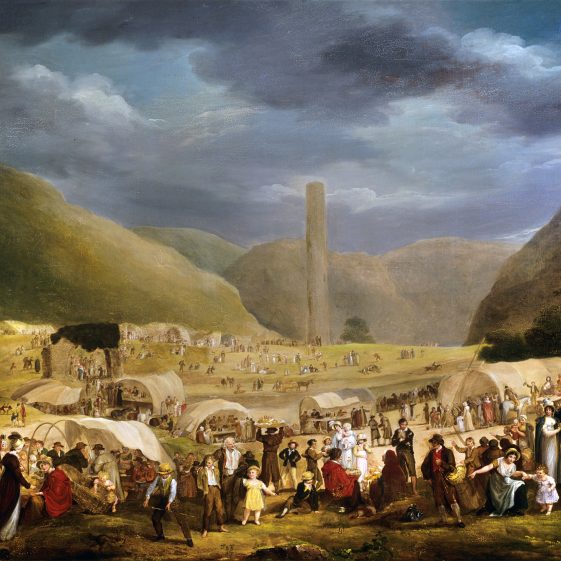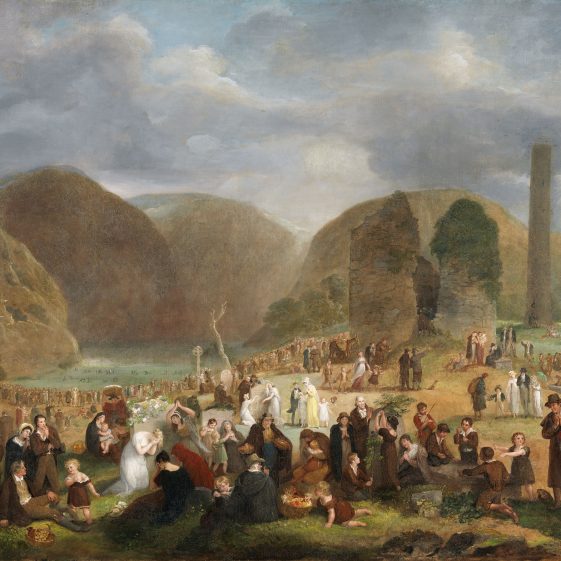Glendalough - Etched, Sketched & Painted
Glendalough: Art & Atmosphere
This article introduces an exhibition of paintings, sketches and drawings of Glendalough showing how artists viewed this historic valley.
The exhibition was put together by Joan Kavanagh and Pat Reid, members of the Glendalough Heritage Forum, as part of the forum’s annual activities for Heritage Week. The exhibition remains on view the the Brockagh Centre, Glendalough and all are welcome to visit. The exhibition was kindly funded by the Heritage Council and Wicklow County Council.
…but a small selection…
The images on view are but a small selection of the many paintings and sketches which were made of this area and come, in the main, from the National Library of Ireland’s Prints and Drawings Collection. Three paintings: the Patron of Glendalough by Joseph Peacock is held in the Ulster Museum, one image of The Pattern at Glendalough by Maria Spilsbury Taylor is from the National Gallery of Ireland, while the second Spilsbury Taylor painting is courtesy of the National Folklore Collection in UCD. These images give a sense of Glendalough as viewed ‘through the artists’ eye’, leaving a legacy of their artistic creations and the atmosphere in which they saw this venerable place.
The picturesque landscape and romanticism of the ruined valley
Glendalough has had many phases in its history: its golden age of monasticism, the introduction of religious orders, the reformation, its decline and then it rising again, like the phoenix in the late 18th century when it again became a place of pilgrimage. This time it was the gentry who were interested in experiencing the picturesque landscape and romanticism of the ruined valley. Glendalough and the Wicklow mountains became an important part of every tourist’s visit to Ireland.
From as early as the 1770s
From as early as the 1770s visitors were coming to Glendalough to view the antiquities and to explore the beauties of the valley. It was seen as important that the ruins which had lain waste for centuries should be recorded for posterity and that the Glendalough of the latter half of the 18th century has been preserved is due in no small manner to the Huguenot artist Gabriel Beranger and the Italian painter and architect Angelo Maria Bigari. They came in October 1779, stayed in Derrybawn House, the home of James Critchley and despite bad weather produced many drawings which were collected in a volume and presented to the Royal Irish Academy.
Resurgent interest in antiquities
Following this resurgent interest in antiquities people such as Edward Wakefield who visited Glendalough in 1809, Sir Walter Scott in 1825, John Barrow in 1835, the German writer Kohl, Bartlett and O’Malley Irwin all came in the 1840s, as did Mr and Mrs Samuel Hall. Since then various illustrated guides have been written, each one giving a personal interpretation of what Glendalough held for that particular individual. These accounts have served Glendalough well over the years as they portrayed Glendalough as a mystical, romantic, picturesque landscape with something on offer for all comers. They were in effect performing the modern day equivalent of the marketing guru, depicting Glendalough as a place that must be seen and therefore enticing further visitors and writers to the Wicklow Mountains.
Many of the images on view in this exhibition were painted or sketched for inclusion in these guides and were an opportunity for people who were unable to travel to view the locations being described. They were the virtual tours of their day!
Biographies of the artists
The Exhibition booklet is attached below in our PDF viewer. This booklet accompanying the exhibition gives brief biographies of the artists, the source of which can be found at http://www.libraryireland.com/irishartists where the reader can access more detailed information. The exception is Paul Sandby whose biography can be viewed in full in The Oxford Dictionary of Art and Artists. The second section relates to extracts from some books in which the images appeared. Extracts have been selected to give a flavour of the writers’ impressions of Glendalough and with the assistance of the images must have given the reader a very good sense of the beauties and antiquities of this special place. The art of the artists, along with the words of the writers, created a lasting atmosphere which we can still enjoy today







































No Comments
Add a comment about this page